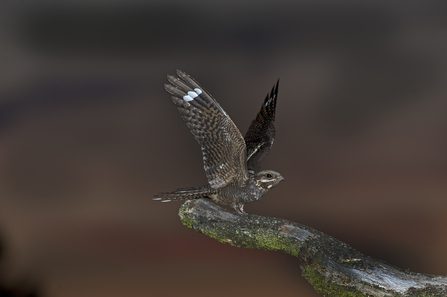On Wednesday 15th May I was lucky enough to be given an evening tour of Norfolk Wildlife Trust's East Wretham Heath in search of a very special nocturnal summer migrant, the nightjar. I met with the warden, James, at 8:30pm. The sky was clear of rain or thunder and crimson cracks ran through the clouds like lightning as I looked out over the reserve; the conditions were perfect! Now all I needed was an expert's knowledge and a sprinkle of luck. James was extremely confident that we would spot a nightjar, and as the sun slumped below the horizon, we began walking across the grassy hill into the valley. The first signs of wildlife we encountered were rabbits grazing the sward tightly, their white tails flashing as they ran over bunds and ridges. Rabbits are key to maintaining these biodiverse Brecks, preserving the heathland.
After climbing through a birch ride past many a gorse bush, the four of us reached a wide blanket of bracken heathland, pockmarked with developing scrub, enclosed by tall columns of conifers. This habitat, with lots of open clearfell is perfect for nightjars as they will feed on moths over open areas near gorse and conifers. Our party waited for signs of activity, and not three minutes later I heard the calls. A shrill ticking churr, with a wooden quality fluctuating in volume, an unmistakable, almost insectoid, noise by a reptilian bird.
I then spotted a large, thickset shape moving across the path of pale light etched by the set sun. Its wings flicked in and out between flat glides with hunched shoulders. In its talons was a dead pigeon, feathers buffeting from the stark wind. It definitely wasn't a nightjar, it was a majestic goshawk, carrying a bountiful feast across the forest clearing. Skimming over the pines and firs, it had the demeaner of a truly powerful hunter, added to by the limp body in its claws. Only as it dived through the bottle-green canopy did I spot something I really didn't expect. A second bird took off near where the smaller male had just landed: a female. This bird was the size of a buzzard, and I realised that there must have been a nest, a male carrying food to a female, and switching shifts? For a bird that has, and still does, suffer so much, it is great news to see goshawks thriving in the Brecks!
After this outstanding encounter with these elusive hawks, the ominous song still reeled out faintly in the distance. We continued to follow it up around the heath and through a channel of birches and even more conifers. This led us to find the nightjars' food source: moths. They flickered off the path in front of us as we walked, flashes of white in the creeping darkness of the woods. Our guide James discussed with me the encounters he has had with nightjars. He told me, "They'll feed over the moth trap sometimes," and I thought about how amazing it must be to watch these birds nearly every week. I reflected on my only previous nightjar encounter, of two males at Minsmere in Suffolk, I hoped our views tonight would be just as good as the hovering spectacle I had witnessed two years ago. Progressing through the woods, the song still rang clear, occasionally pausing only to start up again in the same bubbly vibrato. As we trekked, it became even louder until we cleared the treeline and were greeted by a vast expanse of bracken. This habitat was absolutely perfect for nightjars, so we all waited for the birds to fly.


